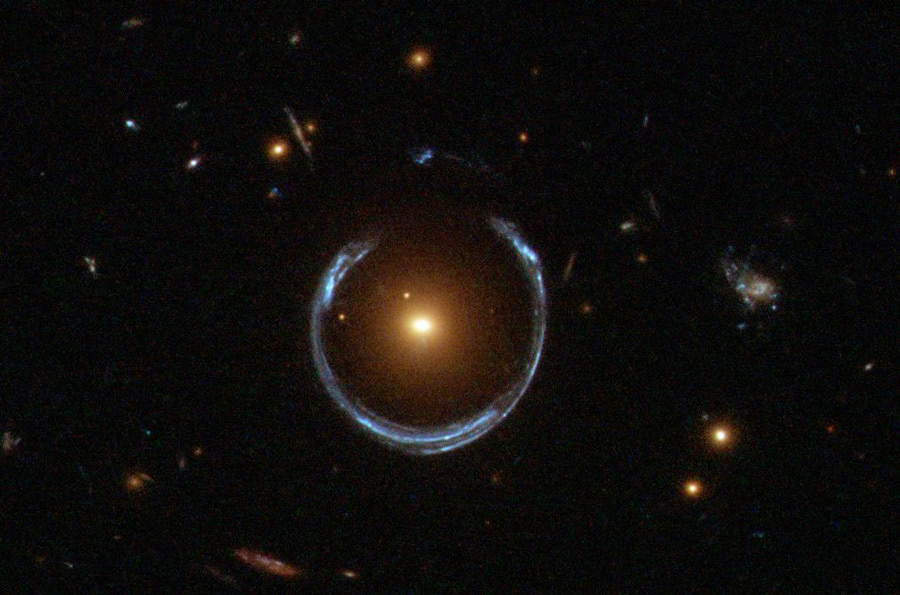What can Occam’s razor principle tell us about theories of dark matter?
Today, physicists have devised dozens of theories to explain the nature of dark matter. So far, however, not one of them has gained concrete proof through experiments. To narrow these theories down, Professor Eugene Oks at Auburn University, USA, advocates applying an important philosophical concept, which is often used when considering complex problems with many candidate solutions. Using Occam’s razor, Oks aims to prove that his own theory of second-flavour hydrogen atoms may offer the best available dark matter candidate.
Dark matter has long remained one of the most elusive mysteries in physics. Through their observations, astrophysicists have now gathered three key pieces of evidence, which each point to the mind-bending result that 85% of all matter in the universe cannot be detected directly – at least with our current understanding of physics.
Three pieces of evidence
The first of these observations concerns the speed at which galaxies rotate about their centres. Current physical theories suggest that the speed of this rotation should slow down towards the outer edge of a galaxy – but this clearly isn’t the case. Instead, rotations maintain their speed as distance from the galactic centre increases – a phenomenon known as the ‘flattening’ of the galactic rotation curve. This should only be possible if galaxies contain vast reservoirs of as-yet undetected mass.

The second piece of evidence stems from an effect first predicted by Einstein: as massive objects distort the structure of spacetime, they can bend the path of light emitted by more distant objects towards us. Named ‘gravitational lensing’, this effect turned out to be far more pronounced in astrophysicists’ observations than would be expected without some unseen source of mass.
The third, most recent piece of evidence comes from the distinctive frequency emitted by neutral hydrogen atoms found in interstellar dust clouds. In their lowest-energy state, the spins of orbiting electrons in these atoms have a small chance of flipping in direction – emitting microwave-frequency electromagnetic waves in the process.
Three pieces of evidence have sparked a decades-long search for an explanation of dark matter’s true nature.With wavelengths of 21 centimetres, these signals become easily detectable in dust clouds containing vast quantities of hydrogen. Yet from their observations of ancient dust clouds, formed early in the universe’s history, astronomers have noticed a significant anomaly in this ‘hydrogen line’ intensity, which cannot be explained by current theories. ‘The consequence of this striking discrepancy was that the gas temperature of the hydrogen clouds was in reality significantly smaller than predicted by the standard cosmology’, Oks explains.
Narrowing the search
Together, these three pieces of evidence have sparked a decades-long search for an explanation of dark matter’s true nature. Physicists today have attempted to solve this mystery through dozens of competing theories – but so far, a complete lack of experimental evidence for almost all of them has made it impossible to conclude which theory comes out on top.

To narrow down these theories, Oks argues that researchers must consider the philosophical principle of Occam’s razor: an idea which can apply to any attempt to tackle an unanswered question, based on incomplete evidence. To do this, a thinker might assume certain pieces of evidence to be true, even if they can’t be certain from their observations.
If concrete proof for these assumptions later appears, the thinker could then reasonably conclude that their theory is correct. Yet according to Occam’s razor, theories which rely more heavily on unproven assumptions are generally at a disadvantage. ‘The principle dictates that when several theories compete, the one that makes fewer assumptions has the upper hand’, Oks explains.
In the case of dark matter research, theories which make unproven assumptions about the nature of the universe are especially prevalent. ‘The overwhelming majority of dark matter theories either introduce exotic subatomic particles which have never been discovered in experiments, or change the laws of physics’, Oks continues. For him, such a heavy reliance on unproven assumptions makes Occam’s razor especially relevant.
Deur’s self-interaction theory
In 2023, Oks published his latest review on dark matter in the journal New Astronomy Reviews. In his review, he argued that out of the dark matter theories currently circulating, just three of them align closely with Occam’s razor. Out of these, just one – his own theory – can fully explain the three key pieces of dark matter evidence identified by astronomers.

The first of these theories was detailed by Alexandre Deur at the University of Virginia. It should be first noted that the laws of motion described by Newton were not disproven by Einstein’s more complete theory of general relativity. Instead, they emerged in the specific case of objects which move far more slowly than the speed of light. A similar principle also applies to Newton’s theory of gravity – which emerges as a special case in the gravitational fields of massive astronomical bodies, including planets and stars.
Even further, the laws of classical mechanics were not disproven by the more complete theory of quantum mechanics. Instead, they emerge in macroscopic systems containing vast numbers of individual atoms – whose strange quantum properties combine to form the classical properties we are more familiar with.
In all three of these cases, classical physics emerges without any need for large corrections to either general relativity or quantum mechanics. However, this picture changes on the scale of galactic clusters – where galaxies interact with each other via gravitational forces far stronger than those of stars or planets.
In a 2019 paper, Deur argues that an effect named ‘self-interaction’ must emerge. Comparable effects, which emerge within systems of interacting quantum particles, have now been widely studied – but far less attention has been given to self-interaction on galactic scales. In this case, the corrections to general relativity demanded by galaxy self-interaction might become far larger – creating the illusion that a vast amount of unseen mass is needed to produce the galactic-scale motions which astronomers observe.

Overall, Deur’s theory provides a feasible alternative to dark matter, without resorting to unproven assumptions about the nature of the universe. Yet as Oks describes, ‘This theory has a disadvantage. It explains only one out of the three major types of astrophysical observations that resorted to dark matter – the flattening of the rotation curves of the galaxies, but not the other two.’
Yahalom’s retardation theory
The second theory which Oks explored in his review of 2023 was devised by Asher Yahalom at Ariel University in Israel. Galaxies draw in gas and dust from the surrounding intergalactic space through a process named ‘accretion’. Over time, this causes galaxies to gain mass, while intergalactic material becomes increasingly depleted – lowering the rate of accretion in turn.
Since galaxies are so vast, it can take tens of thousands of years for light to travel from their centres to their outer edges – meaning the gravitational effects of accretion can take a long time to impact the rest of the entire galaxy. Through his studies, Yahalom proposed that these ‘retardation’ effects could feasibly explain both gravitational lensing and the flattening of galactic rotation curves – both without any need for dark matter.
Oks’ second-flavour hydrogen atoms interact with the universe in fundamentally different ways to ‘regular’ forms of hydrogen atoms: they remain dark.However, retardation theory still can’t explain the mysterious anomalous intensity of the 21-centimetre hydrogen line. In addition, as Oks explains, the theory isn’t entirely free from unproven assumptions. ‘This theory makes an additional assumption of sufficiently large “second time derivative”, or the rate of the rate of change of the galaxy’s mass’, he says. ‘In reality, there are no direct measurements of this quantity.’
Second-flavour hydrogen
The final idea discussed by Oks in his review of 2023 was his own theory, detailed in two previous articles in Research Outreach. Oks’ ‘second-flavour hydrogen atoms’ (SFHA) are based on the usually disregarded second solution of the Dirac equation, which is the fundamental equation of quantum mechanics. It is called ‘flavour’ by the analogy to the different flavours of quarks and leptons in the standard model of particle physics. Since the SFHA practically don’t react with electromagnetic radiation, they interact with the universe in fundamentally different ways to ‘regular’ forms of hydrogen atoms: they remain dark.

Oks has identified four key advantages to his theory. Firstly, unlike Deur and Yahalom’s theories, SFHA has already been confirmed in four different types of real atomic experiments. Secondly, it doesn’t assume the existence of any forces or subatomic particles which aren’t included in the standard model. This leads to the third advantage: that SFHA is based purely on standard principles of quantum mechanics – namely the Dirac equation, which represents quantum properties while still remaining consistent with Einstein’s special relativity.
Finally, as Oks illustrates, ‘SFHA explains all three major types of astrophysical observations that resorted to dark matter, including the anomalous absorption of the 21-centimetre spectral line from the early universe; it also explains why the observed distribution of dark matter is smoother than expected from the Einstein’s gravity.’
Obeying Occam’s razor
In his review of 2023, Oks aimed to prove that out of the dozens of dark matter theories currently being explored, SFHA is the one which best adheres to the philosophical principles of Occam’s razor, while also explaining the three key pieces of astrophysical evidence for dark matter’s existence. If his ideas become more widely accepted within the global physics community, he ultimately hopes that the long-awaited solution to one of the most elusive mysteries in physics may be on the horizon.
Personal Response
Which theory best describes dark matter?I recall a parable where a group of blind men tried to identify a strange animal, called an elephant, by touching it from different sides. Then they argued whether this animal is like a thick snake (after touching its trunk), a kind of fan (after touching its ear), a tree trunk (after touching its leg), a wall (after touching its side), a rope (after touching its tail), or a spear (after touching its tusk). In reality, the elephant is all of the above – a ‘multifaceted phenomenon’. I would not be surprised if it would turn out that dark matter is also a multifaceted phenomenon, whose different astrophysical manifestations are best described by different theories, rather than by one universal theory.
